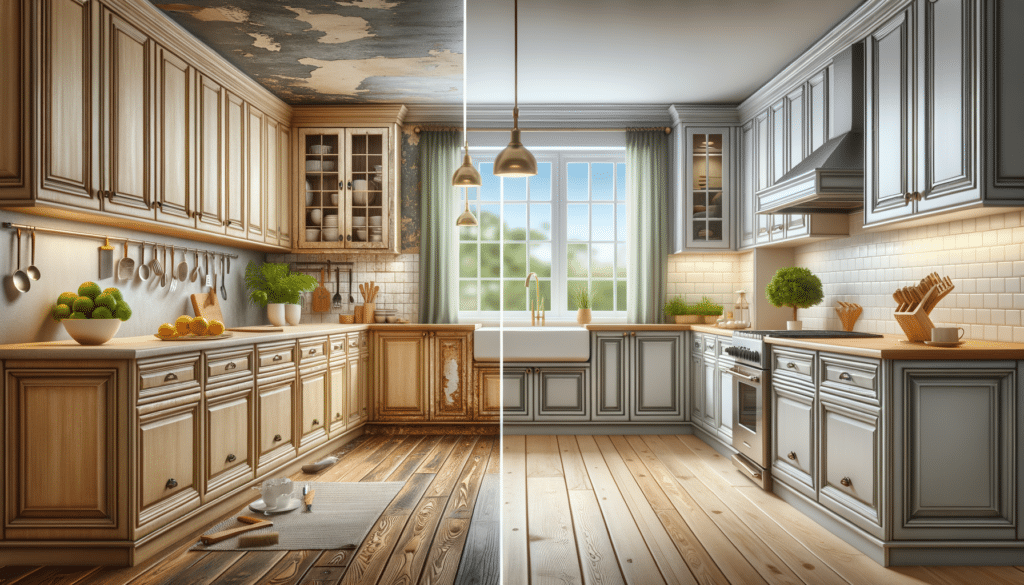Understanding the Importance of Kitchen Cabinet Renovation
Kitchen cabinet renovation is an essential aspect of home improvement that can significantly impact both the aesthetic appeal and functionality of your kitchen. Cabinets are not only practical storage solutions but also play a crucial role in defining the overall look and feel of the space. Over time, kitchen cabinets can become worn out or outdated, making renovation an appealing option for homeowners seeking to refresh their living environment.
Renovating kitchen cabinets can enhance the value of your home. According to real estate experts, a well-renovated kitchen can increase a home’s resale value, making it a wise investment. Moreover, a kitchen renovation can improve the efficiency of the space, allowing for better organization and accessibility. By updating cabinets, homeowners can also integrate modern design trends, ensuring their kitchen remains stylish and functional.
For those concerned about the environmental impact, kitchen cabinet renovation offers an opportunity to make eco-friendly choices. By opting for sustainable materials and finishes, homeowners can reduce their carbon footprint while enjoying a refreshed kitchen space. Ultimately, kitchen cabinet renovation is not just about aesthetics; it is about creating a more enjoyable and efficient living space that aligns with contemporary lifestyle needs.
Choosing the Right Materials for Your Cabinets
When embarking on a kitchen cabinet renovation, selecting the appropriate materials is crucial to achieving the desired outcome. The choice of materials will influence not only the appearance of the cabinets but also their durability and maintenance requirements. Common materials include wood, laminate, and metal, each offering unique benefits and considerations.
Wood is a popular choice for kitchen cabinets due to its timeless appeal and versatility. It can be stained or painted to match any kitchen style, from traditional to modern. However, wood requires regular maintenance to prevent damage from moisture and pests. Laminate, on the other hand, is a cost-effective alternative that offers a wide range of colors and patterns. It is easy to clean and resistant to stains, making it a practical choice for busy households.
Metal cabinets are renowned for their durability and sleek appearance. They are resistant to heat and moisture, making them ideal for kitchens with high humidity levels. However, metal cabinets can be prone to scratches and dents, requiring careful handling. Ultimately, the choice of materials should align with the homeowner’s budget, lifestyle, and design preferences to ensure a successful renovation.
Innovative Design Ideas for Modern Kitchen Cabinets
Modern kitchen cabinet designs are all about maximizing space and enhancing functionality while maintaining a sleek and stylish appearance. One popular trend is the use of open shelving, which creates an airy and spacious feel in the kitchen. Open shelves allow homeowners to display decorative items and frequently used kitchenware, adding a personal touch to the space.
Another innovative design idea is the incorporation of smart storage solutions. Pull-out shelves, lazy Susans, and deep drawers can significantly improve the organization of kitchen items, making them more accessible and reducing clutter. Additionally, integrating lighting within cabinets can enhance visibility and add a touch of luxury to the kitchen.
Color also plays a vital role in modern kitchen cabinet design. Bold colors and contrasting tones can create a striking visual impact, while neutral shades offer a timeless elegance. Homeowners can experiment with different finishes, such as matte or glossy, to achieve the desired look. By embracing these innovative design ideas, homeowners can transform their kitchen into a functional and stylish hub of the home.
Cost Considerations and Budgeting for Cabinet Renovation
Budgeting is a critical component of any kitchen cabinet renovation project. The cost of renovation can vary significantly depending on factors such as the size of the kitchen, the materials chosen, and the complexity of the design. On average, homeowners can expect to spend a substantial amount on cabinet renovation, making it essential to plan and allocate resources wisely.
To manage costs effectively, homeowners should begin by setting a realistic budget that considers all aspects of the renovation, including materials, labor, and any additional features or upgrades. It is advisable to obtain quotes from multiple contractors to ensure competitive pricing and quality workmanship. Additionally, homeowners can explore cost-saving options, such as refacing existing cabinets or opting for ready-to-assemble units.
While it may be tempting to cut corners to save money, it is crucial to prioritize quality and durability to avoid costly repairs or replacements in the future. Investing in high-quality materials and professional installation can ensure a long-lasting and satisfactory renovation outcome. By carefully considering cost factors and budgeting effectively, homeowners can achieve a successful kitchen cabinet renovation that enhances both the value and enjoyment of their home.
DIY vs. Professional Cabinet Renovation: Pros and Cons
Deciding between a DIY approach and hiring professionals for kitchen cabinet renovation is a common dilemma for homeowners. Both options have their advantages and drawbacks, making it essential to weigh them carefully before making a decision. DIY renovation can be an appealing choice for those with a knack for home improvement and a desire to save on labor costs.
One of the primary benefits of DIY renovation is the potential for cost savings. By undertaking the project themselves, homeowners can avoid labor fees and allocate their budget towards higher-quality materials. Additionally, DIY projects offer a sense of accomplishment and the opportunity to customize the renovation to personal preferences. However, DIY renovation requires a significant time investment and a certain level of skill and expertise to achieve professional results.
On the other hand, hiring professionals ensures a high-quality finish and can save homeowners time and effort. Professional contractors have the experience and tools necessary to handle complex tasks and unforeseen challenges, ensuring a smooth renovation process. However, professional services come at a higher cost, and homeowners must carefully vet contractors to ensure reliability and quality workmanship.
Ultimately, the choice between DIY and professional renovation depends on factors such as budget, time availability, and personal skill levels. By considering the pros and cons of each approach, homeowners can make an informed decision that aligns with their renovation goals and resources.




